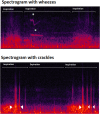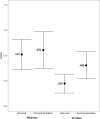The use of spectrograms improves the classification of wheezes and crackles in an educational setting
- PMID: 32440001
- PMCID: PMC7242373
- DOI: 10.1038/s41598-020-65354-w
The use of spectrograms improves the classification of wheezes and crackles in an educational setting
Abstract
Chest auscultation is a widely used method in the diagnosis of lung diseases. However, the interpretation of lung sounds is a subjective task and disagreements arise. New technological developments like the use of visSual representation of sounds through spectrograms could improve the agreement when classifying lung sounds, but this is not yet known. In this study, we tested if the use of spectrograms improves the agreement when classifying wheezes and crackles. To do this, we asked twenty-three medical students at UiT the Arctic University of Norway to classify 30 lung sounds recordings for the presence of wheezes and crackles. The sample contained 15 normal recordings and 15 with wheezes or crackles. The students classified the recordings in a random order twice. First sound only, then sound with spectrograms. We calculated kappa values for the agreement between each student and the expert classification with and without display of spectrograms and tested for significant improvement between these two coefficients. We also calculated Fleiss kappa for the 23 observers with and without the spectrogram. In an individual analysis comparing each student to an expert annotated reference standard we found that 13 out of 23 students had a positive change in kappa when classifying wheezes with the help of spectrograms. When classifying crackles 16 out of 23 showed improvement when spectrograms were used. In a group analysis we observed that Fleiss kappa values were k = 0.51 and k = 0.56 (p = 0.63) for classifying wheezes without and with spectrograms. For crackles, these values were k = 0.22 and k = 0.40 (p = <0.01) in the same order. Thus, we conclude that the use of spectrograms had a positive impact on the inter-rater agreement and the agreement with experts. We observed a higher improvement in the classification of crackles compared to wheezes.
Conflict of interest statement
The authors declare no competing interests.
Figures






Similar articles
-
International perception of lung sounds: a comparison of classification across some European borders.BMJ Open Respir Res. 2017 Dec 18;4(1):e000250. doi: 10.1136/bmjresp-2017-000250. eCollection 2017. BMJ Open Respir Res. 2017. PMID: 29435344 Free PMC article.
-
Computerized respiratory sounds: a comparison between patients with stable and exacerbated COPD.Clin Respir J. 2017 Sep;11(5):612-620. doi: 10.1111/crj.12392. Epub 2015 Oct 12. Clin Respir J. 2017. PMID: 26403859
-
Prevalence and clinical associations of wheezes and crackles in the general population: the Tromsø study.BMC Pulm Med. 2019 Sep 11;19(1):173. doi: 10.1186/s12890-019-0928-1. BMC Pulm Med. 2019. PMID: 31511003 Free PMC article.
-
[Pulmonary auscultation in the era of evidence-based medicine].Rev Mal Respir. 2008 Jun;25(6):674-82. doi: 10.1016/s0761-8425(08)73797-5. Rev Mal Respir. 2008. PMID: 18772825 Review. French.
-
Wheezes.Eur Respir J. 1995 Nov;8(11):1942-8. doi: 10.1183/09031936.95.08111942. Eur Respir J. 1995. PMID: 8620967 Review.
Cited by
-
Breath characteristics and adventitious lung sounds in healthy and asthmatic horses.J Vet Intern Med. 2024 Jan-Feb;38(1):495-504. doi: 10.1111/jvim.16980. Epub 2024 Jan 8. J Vet Intern Med. 2024. PMID: 38192117 Free PMC article.
-
The Usefulness of Continuous Respiratory Sound Monitoring for the Detection of Pulmonary Atelectasis in a Ventilated Extremely Low Birth Weight Infant.Cureus. 2024 Jul 25;16(7):e65394. doi: 10.7759/cureus.65394. eCollection 2024 Jul. Cureus. 2024. PMID: 39184734 Free PMC article.
-
Review on the Advancements of Stethoscope Types in Chest Auscultation.Diagnostics (Basel). 2023 Apr 25;13(9):1545. doi: 10.3390/diagnostics13091545. Diagnostics (Basel). 2023. PMID: 37174938 Free PMC article. Review.
-
Interrater and intrarater agreement on heart murmurs.Scand J Prim Health Care. 2022 Dec;40(4):491-497. doi: 10.1080/02813432.2022.2159204. Epub 2023 Jan 4. Scand J Prim Health Care. 2022. PMID: 36598178 Free PMC article.
-
The seventh survey of the Tromsø Study (Tromsø7) 2015-2016: study design, data collection, attendance, and prevalence of risk factors and disease in a multipurpose population-based health survey.Scand J Public Health. 2022 Nov;50(7):919-929. doi: 10.1177/14034948221092294. Epub 2022 May 4. Scand J Public Health. 2022. PMID: 35509230 Free PMC article.
References
-
- Margolis P, Gadomski A. The rational clinical examination. Does this infant have pneumonia? JAMA. 1998;279:308–313. - PubMed
Publication types
MeSH terms
LinkOut - more resources
Full Text Sources
Medical

